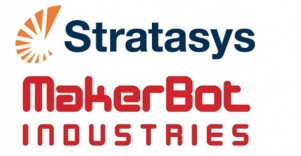
Buying into a Hot Industry: 3D Printing, MakerBot and Stratasys
Yesterday, Stratasys, the industrial-focused inventors of the most common type of plastic 3D printing technology, purchased the consumer-focused MakerBot for $403M with up to $201M in earn-outs. To many the acquisition was a bit unexpected and illogical, especially since Stratasys is still integrating a massive acquisition they made last year. However, according to Jordan Brandt, Technology Futurist at Autodesk, it makes perfect strategic sense.
“It was a great way for Stratasys to enter the consumer market, where they had no access before, and it gives MakerBot the resources they need.” He explained, “MakerBot was in a fundraising process already and it gives them access to significant shared resources. A lot of the fundamental technologies are the same.”
Ever since Stratasys invented the process of fused deposition modeling (FDM) in the late 80s, the process that is most often associated with 3D printing, they have focused exclusively on high-value industrial plastic applications. When their main patent on FDM expired in 2005, Stratasys stayed focused on their core, not thinking much of the tiny hobbyists and niche companies who started using the technology to create consumer focused 3D printers. Today there are more than 200 3D printers competing in the consumer space, leaving little room for Stratasys to enter. At least until they acquired MakerBot, arguably the best-known company in consumer 3D printers.
The marriage between Stratasys and MakerBot may not seem obvious at first, but it could be an attempt to harness a trend that has already stated with brands. “Nike is already leveraging 3D printing for shoes with both Adidas and New Balance following close behind. Fashion and apparel are going to be quickly impacted. While full 3D printing of consumer items doesn’t make sense yet, as it’s still too expensive, I think there is going to be a hybrid model with some custom components being printed and assembled with mass-produced components. They’re not mutually exclusive,” Brandt explained.
Though much of the experimentation by big brands is at the industrial scale where Stratasys has a strong presence, that could be changing in the very near future – a future that MakerBot is leading the charge into. As Brandt described, “People want brands, not generic items, which will impact the adoption of 3D printing by consumers. But brands are starting to adopt new models. Brands are creating designs you can download and print.”
As he continued, describing the future state of plastic 3D printing, it seemed obvious why Stratasys felt like they had to make the acquisition: “There’s a common analogy to the use of microwaves. Not everything can be made in a microwave, but many things can and most households have one. I think there’s a future state where every household has a 3D printer, but not everything will be made with them.”
Beyond the strictly consumer market discussed by Brandt, MakerBot had started to encroach on industrial prototyping, forcing Stratasys to make a decision to compete or acquire. As David Reis, CEO of Stratasys, said in yesterday’s press release, “MakerBot 3D printers are rapidly being adopted by CAD-trained designers and engineers,” before continuing, “MakerBot has impressive products, and we believe that the company’s strategy of making 3D printing accessible and affordable will continue to drive adoption.”
Despite the need to acquire their way into a market they had overlooked, Stratasys seems to have found long-term partners rather than a simple acquihire or sell-out. The stock-for-stock transaction indicates both the investors and the founders of MakerBot want to stay actively involved and see only a growing future in 3D printing. As Brandt noted, “3D printing is one of the, if not the most, significant megatrends that will impact manufacturing in the next decade.”